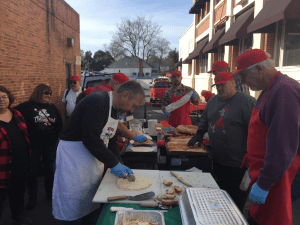Master Gardeners Talk About Planting Garlic
Garlic is a fun herb to grow and does not require a lot of your time or effort. But just like any edible, it requires a little preparation and planning. Ordering your seed garlic (cloves) from a catalog works best. Order in July or August for fall planting. If you don’t have time to do this, you can buy it in the grocery store. The downside of doing this is that a sprout inhibiter is often sprayed on grocery store garlic. This has never been a problem for me, however, and the upside is that you will likely get a price break this way.
In California, garlic is a cool-weather crop, and the soft neck variety does best. Fall is the time to plant. It may start to sprout in the winter but will go dormant and start to grow again in the spring. With garlic, you are in it for the long haul, as it takes 5-8 months to mature.
The first step, after you have purchased your garlic, is to gently break the cloves apart, leaving the outer skin intact on each clove. Now for the soil preparation. Choose a sunny location. Sandy loam is ideal, but if your soil has clay in it, be sure that you loosen the soil before planting to about 4 inches in depth. The cloves will be planted at about 2 inches down, but the soil should be loose below the clove so that the water will not sit around the base and root area. A standard soil amendment should give adequate nourishment. Water the soil a day before planting.
Another chore before planting day, to improve the odds of a good yield, is to soak the cloves overnight in a baking soda solution of about 1 teaspoon per quart of water. This will help to kill any bacteria on the cloves. Drain off the cloves about an hour before planting and soak them in a new bath of isopropyl alcohol to kill any fungus.
Plant the cloves pointed side up, about 2 inches deep and about 8 inches apart in all directions. Water them again and then cover the bed with straw. When the tips of the plants appear, move the straw away from the plants to give them space. Now you just need to keep the soil moist. Do not overwater!
The garlic will continue to grow slowly. The plants should be fertilized again in the spring. Stop fertilizing the plants about 3 months before harvest. So, if you planted in late September, you would stop fertilizing in late February. Now watch the leaves. The lower leaves will start to brown as the bulbs mature, and this browning will continue upward.
As the leaves continue to brown, stop watering for 1-2 weeks before harvesting. Using a garden fork, try to dig below the root and avoid pulling up by hand. You want the garlic bulbs to stay intact and have about 2 inches of roots. Remove loose clods of dirt only. Once you have completed your harvest, the garlic can be cured in a dry shaded place with good air circulation, either inside or out. This curing process allows the vascular tissues to close and the bulb to harden. Larger bulbs should be ready to use in about 4 weeks but can often be stored for a few months.
Good luck and happy gardening.
More resources: https://vric.ucdavis.edu/pdf/garlic.pdf, http://sfp.ucdavis.edu/pubs/SFNews/archives/95071/
Wendy Kubow is a University of California Cooperative Extension Master Gardener of Calaveras.
UCCE Master Gardeners of Tuolumne and Calaveras Counties can answer home gardening questions. Call 209-533-5912 or fill out our easy-to-use problem questionnaire here. Check out our website here. You can also find us on Facebook.

